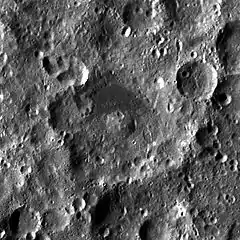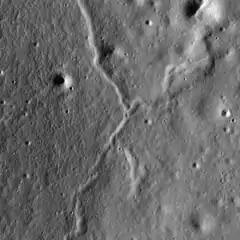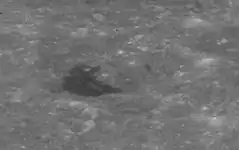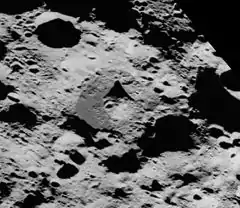Bolyai (crater)
Bolyai is an old lunar impact crater that is located in the southern hemisphere on the far side of the Moon. To the southeast of Bolyai is the crater Eötvös, and to the north is Neujmin. It is named after the 19th century Hungarian mathematician János Bolyai.
 LRO WAC image | |
| Coordinates | 33.6°S 125.9°E |
|---|---|
| Diameter | 135 km |
| Depth | Unknown |
| Colongitude | 236° at sunrise |
| Eponym | János Bolyai |



This crater has been heavily eroded and worn by subsequent impacts, leaving only a deformed remnant of the original rim that is overlaid by a multitude of lesser craters. The most notable of these is Bolyai D along the northeast rim and Bolyai W to the northwest. The latter is actually a formation of multiply overlapping craters.
The interior of the crater is relatively level, but rough in places due to impacts that have reshaped the surface. Near the rounded central peak, and from there towards the northern rim, is a section of floor that has been resurfaced by lava flows. This area is smoother than the remainder of the floor, and has a lower albedo, giving it a dark appearance.
Satellite craters
By convention these features are identified on lunar maps by placing the letter on the side of the crater midpoint that is closest to Bolyai.
| Bolyai | Latitude | Longitude | Diameter |
|---|---|---|---|
| D | 32.5° S | 128.0° E | 34 km |
| K | 36.3° S | 126.8° E | 29 km |
| L | 36.3° S | 126.2° E | 73 km |
| Q | 36.1° S | 122.5° E | 28 km |
| W | 32.2° S | 123.9° E | 50 km |
References
- Andersson, L. E.; Whitaker, E. A. (1982). NASA Catalogue of Lunar Nomenclature. NASA RP-1097.
- Blue, Jennifer (July 25, 2007). "Gazetteer of Planetary Nomenclature". USGS. Retrieved 2007-08-05.
- Bussey, B.; Spudis, P. (2004). The Clementine Atlas of the Moon. New York: Cambridge University Press. ISBN 978-0-521-81528-4.
- Cocks, Elijah E.; Cocks, Josiah C. (1995). Who's Who on the Moon: A Biographical Dictionary of Lunar Nomenclature. Tudor Publishers. ISBN 978-0-936389-27-1.
- McDowell, Jonathan (July 15, 2007). "Lunar Nomenclature". Jonathan's Space Report. Retrieved 2007-10-24.
- Menzel, D. H.; Minnaert, M.; Levin, B.; Dollfus, A.; Bell, B. (1971). "Report on Lunar Nomenclature by the Working Group of Commission 17 of the IAU". Space Science Reviews. 12 (2): 136–186. Bibcode:1971SSRv...12..136M. doi:10.1007/BF00171763. S2CID 122125855.
- Moore, Patrick (2001). On the Moon. Sterling Publishing Co. ISBN 978-0-304-35469-6.
- Price, Fred W. (1988). The Moon Observer's Handbook. Cambridge University Press. ISBN 978-0-521-33500-3.
- Rükl, Antonín (1990). Atlas of the Moon. Kalmbach Books. ISBN 978-0-913135-17-4.
- Webb, Rev. T. W. (1962). Celestial Objects for Common Telescopes (6th revised ed.). Dover. ISBN 978-0-486-20917-3.
- Whitaker, Ewen A. (1999). Mapping and Naming the Moon. Cambridge University Press. ISBN 978-0-521-62248-6.
- Wlasuk, Peter T. (2000). Observing the Moon. Springer. ISBN 978-1-85233-193-1.
